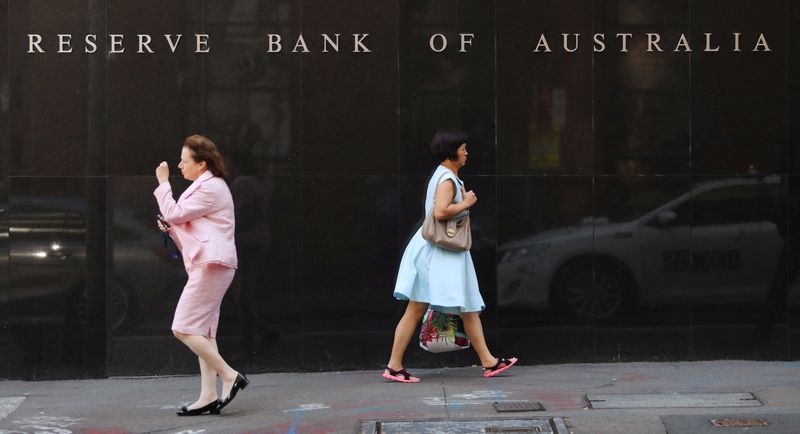By Wayne Cole and Stella Qiu
SYDNEY (Reuters) – Australia’s central bank held interest rates steady at its last meeting of the year on Tuesday, but softened its hawkish tone by noting the board had gained “some confidence” that inflation was heading back to target.
The Australian dollar fell 0.8% to $0.6380 and there-year bond futures rallied 5 ticks to 96.26, the highest since October. Swaps now imply there is a split chance of a rate cut in February, with a first easing more than fully priced in by April next year.
Wrapping up its December policy meeting, the Reserve Bank of Australia kept the cash rate unchanged at 4.35% where it has been all year. However, the statement omitted a previous line that the RBA Board was “not ruling anything in or out” as well as policy needing to remain restrictive.
Markets had heavily wagered on a steady outcome as RBA Governor Michele Bullock has repeatedly said that underlying inflation is still too high for rate cuts in the near-term, including just two weeks ago.
“Recent data on inflation and economic conditions are still consistent with these forecasts, and the Board is gaining some confidence that inflation is moving sustainably towards target,” the RBA Board said in a statement.
Headline inflation slowed to 2.8% in the third quarter, back in the target band, but that was thanks to temporary government rebates on electricity bills, while core inflation was stubborn at 3.5%.
“The RBA left no doubt that it isn’t happy with current levels of core inflation but by twice saying that it is ‘gaining confidence’ in the inflation outlook, hopes have risen that the first cut could be in February after all,” Sean Callow, a senior analyst at ITC (NS:ITC) Markets.
“Removing the ‘not ruling anything in or out’ line is very welcome and probably overdue. Importantly, the RBA agreed with markets in viewing the Q3 national accounts as very weak rather than trying to find a silver lining,” he said.
PIVOT TO FEB RATE CUT?
The RBA has held its policy steady for over a year now while other global policymakers, including the U.S. Federal Reserve, have started cutting rates from their record highs. The central bank has said that the current restrictive rate of 4.35% – up from 0.1% during the pandemic – is required to bring inflation to its target band of 2-3%.
Some investors had bet the RBA could take a dovish turn after data showed economic growth in the third quarter was surprisingly weak, implying the central bank will have to cut its economic forecasts just one month after publishing them.
Indeed, a survey from the National Australia Bank (OTC:NABZY) released earlier in the day showed that business conditions slid to the lowest since late 2020 in November, suggesting the economy hasn’t picked up momentum as expected this quarter.
An anticipated rebound in consumer spending has yet to appear either, with consumers largely holding onto the windfall from the government’s tax cuts and paying off debt, according to bank research.
On the brighter side, the labour market has stayed surprisingly strong, helped by a surge in public sector jobs, with the jobless rate little changed at 4.1% for more than six months now. Wage growth, however, has underwhelmed.
“While it would be premature for the RBA to unroll its ‘mission accomplished’ flag, today’s dovish pivot has paved the way for a February rate cut button pending a further softening in the incoming data,” said Tony Sycamore, analyst at IG.



